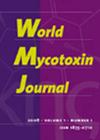Interlaboratory collaboration to determine the performance of the Randox food diagnostics biochip array technology for the simultaneous quantitative detection of seven mycotoxins in feed
IF 1.7
4区 医学
Q3 FOOD SCIENCE & TECHNOLOGY
引用次数: 2
Abstract
An inter-laboratory collaborative study was performed to evaluate the performance of the Biochip Array Technology (BAT) Myco 7 method. The Myco 7 Array is a method which simultaneously and quantitatively detects 20 mycotoxins including aflatoxins B1, B2, G1 and G2, ochratoxin A, deoxynivalenol, zearalenone, fumonisin B1, B2 and B3 and T-2 and HT-2 toxin. The BAT Myco 7 method was collaboratively evaluated by nine government and private Association of American Feed Control Officials (AAFCO) laboratories. Samples were analysed in a proficiency testing round format. Seventeen blind samples were analysed on the same equipment using Myco 7 kits. 99% of the results fell within an acceptable Z-score range of -2|实验室间合作,确定Randox食品诊断生物芯片阵列技术同时定量检测饲料中七种真菌毒素的性能
进行了一项实验室间合作研究,以评估生物芯片阵列技术(BAT)Myco 7方法的性能。Myco 7阵列是一种同时定量检测20种真菌毒素的方法,包括黄曲霉毒素B1、B2、G1和G2、赭曲霉毒素a、脱氧雪腐镰刀菌烯醇、玉米赤霉烯酮、伏马菌素B1、B2和B3以及T-2和HT-2毒素。BAT Myco 7方法由九个政府和私人美国饲料控制官员协会(AAFCO)实验室共同评估。样本以能力测试轮形式进行分析。使用Myco 7试剂盒在同一设备上分析了17个盲样本。99%的结果在-2|
本文章由计算机程序翻译,如有差异,请以英文原文为准。
求助全文
约1分钟内获得全文
求助全文
来源期刊

World Mycotoxin Journal
MYCOLOGY-
CiteScore
4.60
自引率
5.00%
发文量
25
审稿时长
>12 weeks
期刊介绍:
''World Mycotoxin Journal'' is a peer-reviewed scientific journal with only one specific area of focus: the promotion of the science of mycotoxins. The journal contains original research papers and critical reviews in all areas dealing with mycotoxins, together with opinions, a calendar of forthcoming mycotoxin-related events and book reviews. The journal takes a multidisciplinary approach, and it focuses on a broad spectrum of issues, including toxicology, risk assessment, worldwide occurrence, modelling and prediction of toxin formation, genomics, molecular biology for control of mycotoxigenic fungi, pre-and post-harvest prevention and control, sampling, analytical methodology and quality assurance, food technology, economics and regulatory issues. ''World Mycotoxin Journal'' is intended to serve the needs of researchers and professionals from the scientific community and industry, as well as of policy makers and regulators.
联系我们:info@booksci.cn
Book学术提供免费学术资源搜索服务,方便国内外学者检索中英文文献。致力于提供最便捷和优质的服务体验。
Copyright © 2023 布克学术 All rights reserved.
京ICP备2023020795号-1
 京公网安备 11010802042870号
京公网安备 11010802042870号
京ICP备2023020795号-1

Book学术文献互助群
群 号:481959085

 求助内容:
求助内容: 应助结果提醒方式:
应助结果提醒方式:
